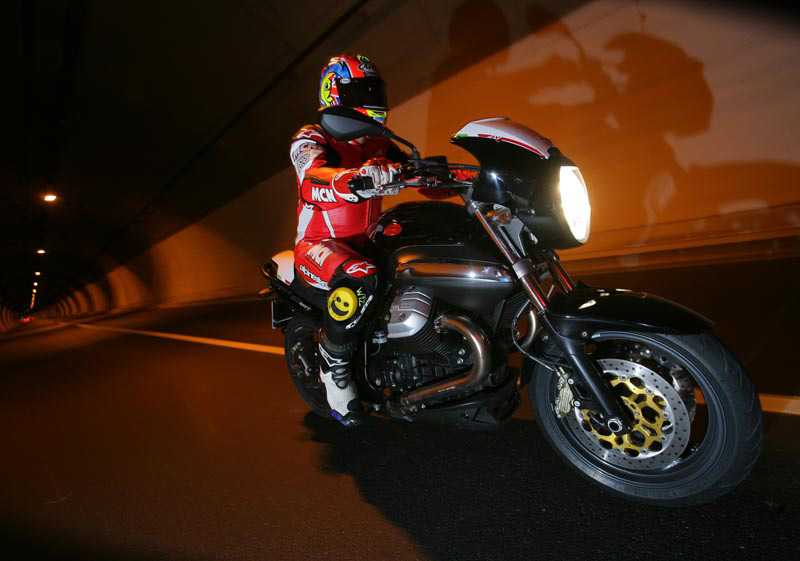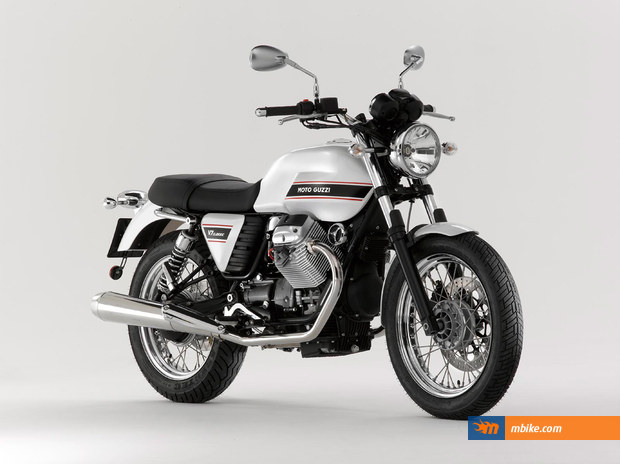There are many things you probably don’t know about Moto Guzzi. For example, it’s Europe’s longest continually-running bike manufacturer. Or that the brand was founded by two WWI pilots and their mechanic. Or that they built the world’s first motorcycle-specific wind tunnel. Basically, Moto Guzzi was the Ferrari os motorcycle racing, a brand that was as successful on the racetrack as its counterpart from Maranello.
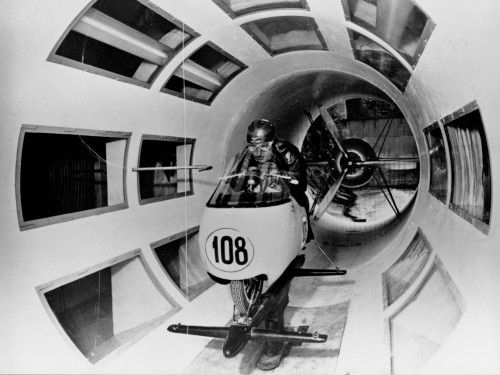
Guzzi opened its own wind tunnel in 1950
On 15 March 1921, the company “Società Anonima Moto Guzzi” was constituted in the offices of the notary Paolo Cassanello in Corso Aurelio Saffi, Genoa, for “the fabrication and sale of motorcycles, and all other activities pertinent or correlated to the metalworking and mechanical engineering industries”. The partners in the Company were the renowned Genoese ship owner Emanuele Vittorio Parodi, his son Giorgio and his friend Carlo Guzzi. Guzzi was a former comrade of Parodi’s in the Italian Air Corps, as was another friend Giovanni Ravelli, an aviator – like Parodi – who died, however, on 11 August 1919 during a test flight. It was in memory of this friend that the spread-winged eagle motif in the Moto Guzzi badge was chosen.
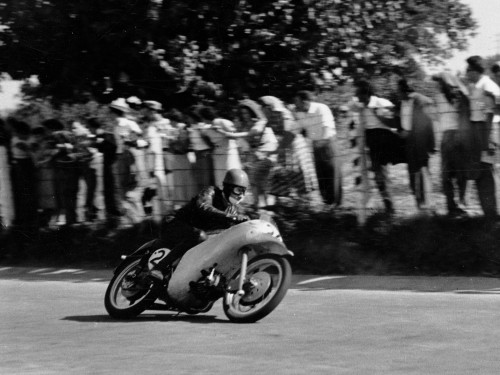
Enrico Lorenzetti on his 1953 race bike
The company’s first motorcycle was the legendary 8 HP Normale. This was followed by successful models such as the 1928 Guzzi G.T., dubbed “Norge” to commemorate the expedition to the Polar Arctic Circle, and the Airone 250 (1939), which remained Italy’s best selling medium capacity motorcycle for over 15 years. In the meanwhile, the marque also notched up numerous racing successes. The first was in the prestigious Targa Florio in 1921, which marked the beginning of an impressive succession of victories: up until its withdrawal from motorsports in 1957, Moto Guzzi accumulated an enviable collection of accolades including, among other titles, an astonishing 14 world GP championships and 11 Tourist Trophies.
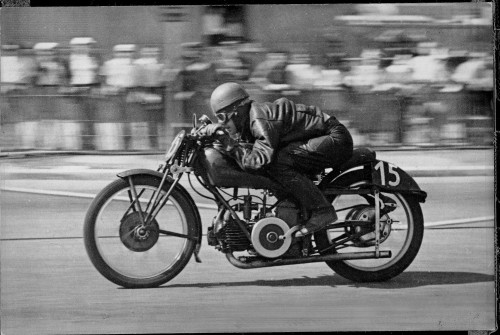
Guzzi was very successul on the racetrack
The years following the Second World War spawned models such as the Guzzino 65 (“Cardellino”), which was Europe’s best selling motorcycle for over a decade. This was followed by the legendary Galletto (1950) and the Lodola 175 (1956). In 1950, Moto Guzzi installed a state of the art wind tunnel at Mandello del Lario, making it the first constructor worldwide to do so. The company’s racing division was a team of brilliant minds, with engineers such as Umberto Todero, Enrico Cantoni andthe Milanese Giulio Cesare Carcano, who would soon achieve legendary status for creating the 285 Km/h Guzzi Otto Cilindri.
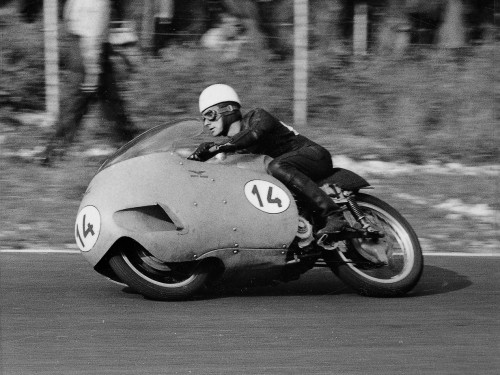
1957 Guzzi with Keith Campbell
At the end of the 1960s, Moto Guzzi presented the 90° V-twin engine that was to become the very symbol of Moto Guzzi itself. This powerplant was used as the basis for models such as the Guzzi V7, the V7 Special and yet another icon, the Guzzi V7 Sport.The glorious V-twin was also produced as smaller capacity V35 and V50 variants. The largest iteration of this engine powered the definitive Gran Turismo – the Moto Guzzi California, which evolved to include electronic injection and a triple-disc brake system. Dedicated to the US market, together with the Ambassador and Eldorado variants, the California boasted the classic 850 cc engine capacity, a displacement that has since been rediscovered and brought back into the current range. Models like the Le Mans, Daytona, Centauro and Sport 1100 kept the sports heritage of the marque alive. The unmistakable style and character of these bikes were brought right up to datein the 1990s with the new California, Nevada and V11 Sport series.
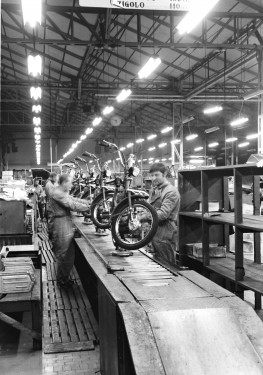
New Moto Guzzi bikes
On 30 December 2004 Moto Guzzi became a part of the Piaggio Group (chairman and managing director Roberto Colaninno), the European leader in the two-wheeler market and one of the world’s major constructors in the sector. Expressing the spirit of this renaissance was the Breva 1100 presented in March 2005, a new and successful Italian offering for the naked segment. September that same year saw the widely acclaimed launch of the Griso 1100, a bike boasting original engineering solutions and unique styling. From April 2006, the Breva and Griso have also been offered with Guzzi’s hallmark 850 cc engine size.
In May 2006, the Norge 1200 marked Guzzi’s return to the Gran Turismo genre: a bike offering total protection from the elements, the new 1200cc V-twin engine and uncompromisingly generous standard equipment for devouring miles in complete comfort. The Norge earned the admiration of the 14 journalists who, in July 2006, rode a convoy of the bikes 4,429 Km to Cape North, following the route taken in 1928 by the bike’s predecessor – the GT 500 created by Giuseppe Guzzi.
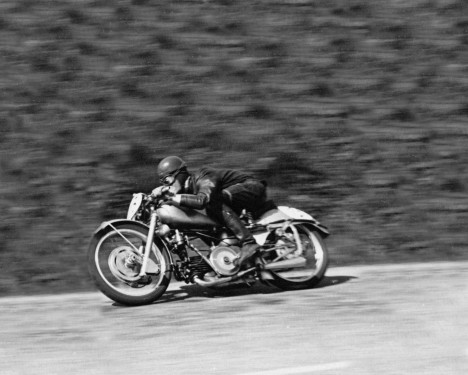
Moto Guzzi History
Testifying to the great passion that unites all Moto Guzzi owners, between 15 and 17 September, 15 thousand Guzzisti from over 20 different countries flocked to Mandello del Lario for the fourth edition of GMG (‘Giornate Mondiali Guzzi’ – World Guzzi Days). Overseen by the Moto Guzzi Club, the countless Guzzi owners’ associations around the world boast an unparalleled loyal following. There are over 25,000 Motor Guzzi motorcycle club members worldwide (the largest group of which in the USA, with 52 clubs in the country), and more than 70 internet websites dedicated to the brand.
Moto Guzzi: The Complete History from 1921
Moto Guzzi has answered the dreams of its loyal fans, and the sporting heart of the Mandello Eagle is beating once again: in March 2006 at the legendary Daytona circuit, Gianfranco Guareschi scored a historic double victory by winning both heats of the Battle of Twins. On 6 March 2007, Guareschi repeated the performance and won the following year’s edition in the saddle of his trusty Moto Guzzi. Spurred by these racing victories on the other side of the Atlantic, a new model was created to embody the sporting spirit of Moto Guzzi – the 1200 Sport. Presented in October 2006, the 1200 Sport is a sophisticated naked, brimming with personality in every aspect of its design, chassis architecture and ergonomics, and powered by the latest 1200 cc generation of the 90° V-twin.
2007 saw the Mandello based brand bursting with even more life than ever. At the 64th edition of the Milan EICMA Show at the end of 2006, Moto Guzzi presented the Griso 8V – an evolution of brand’s mesmerising naked powered by a new 4-valve engine producing over 110 hp – and the Bellagio, a custom powered by an oversquare 940 cc engine. During the global Piaggio Dealer convention held in Berlin in February 2007, the project for a new Moto Guzzi was unveiled – a large street enduro with the evocative name: Stelvio.
On 26 March 2007, against the backdrop of Lake Como, Moto Guzzi once again proved that it keeps its promises by presenting the definitive version of the Bellagio to the press just a few months after the Milanese show, while the followingSeptember, it unveiled the powerful Griso 1200 8V.
2007 was also the year of the Giornate Mondiali Moto Guzzi event, which was given an even more exclusive touch by the appearance by the cinema star Ewan McGregor. The actor had come to Mandello del Lario to collect his white California Vintage, which he had purchased a few months previously when filming scenes for his adventure TV show Long Way Down at the Guzzi factory. EICMA 2007 was the setting for the world preview presentation of two models at opposite ends of the spectrum in the comprehensive Moto Guzzi range: the Stelvio 1200 and the V7 Classic. The Stelvio 1200 was presented to the international press in March 2008 in the medieval town of Rocca Salimbeni, the home of the Monte dei Paschi di Siena bank, while the following May, journalists were given their first chance to test the abilities of the nimble V7 Classic on the streets of Milan.
A significant testimony to the brand’s quality came when Guzzi won the contract to supply 35 Moto Guzzi Norge GTs to the Berlin police, while 20 Moto Guzzi California Vintage bikes were delivered to the Corazzieri Italian Presidential guard corps the same year. 2009 saw the introduction of the V7 Cafè, a sports variant of the V7 to join the existing Classic, presented in Rome together with the Griso SE in March, and of the Stelvio NTX, which marked the introduction of ABS on the Guzzi’s maxi enduro. This bike, presented to the international press on the roadsof the Dolomites, is powered by the first upgrade of the “Quattrovalvole” engine, with new camshafts.
At the end of 2009, during the 67th International Motorcycle Show in Milan,Moto Guzzi captured the world’s attention with three futuristic prototypes designed by Miguel Galluzzi and Pierre Terblanche: V12LM, V12 Strada and V12 X, which immediately received the Motorcycle Design Association Award (a design association with 165 members in four continents) for the best motorcycle design.
In late 2009 the Piaggio Group also announced a significant investment programme, which involves not only the development of future Moto Guzzi product ranges but also the Mandello del Lario production facility, where a major restructuring project is currently in progress to make the plant more modern, functional and efficient to reflect the rebirth of the brand.
A spate of new Moto Guzzi models was also unveiled at the 2010 edition of EICMA Milan. The all-new family of large 1200 8V bikes with four valves per cylinder – namely the Stelvio 1200 8V, the Stelvio 1200 NTX and the Norge GT 8V – was presented at the show, while the press launch for the bikes was held on the roads of Tuscany in Spring 2011.
This year also saw the launch of the V7 Racer, a genuine production special with a 750cc engine inspired by the tuned specials of the 1970s based on the V7 Sport. The V7 Racer celebrates Moto Guzzi’s traditional styling cues in a savvy mix of technology and exquisite craftsmanship. Details such as the chromed tank embellished with an elegant leather strap, and metal accents in the Moto Guzzi badge colour-matched with the red frame capture the attention at first glance. Boasting a small block engine of the same capacity is the Nevada Anniversario, which celebrates twenty years of the “baby” Guzzi with a new sports custom to join the ever popular Classic.
2011 – the year of the 90th anniversary of Moto Guzzi – started off with a pleasant surprise: an all new version of the Moto Guzzi California. The prototype for the new California, powered by an all-new 1400 cc transverse 90° V-twin, reinterprets the legacy of a legendary motorcycle in an original new design that emphasises both the architecture of the engine and the generous dimensions of the saddle and the tank, which is sculpted around the cylinders.
But 2011 has many more exciting things in store to mark the 90th birthday of the Eagle brand: on 15 March, the Piaggio Group celebrated the official anniversary of the foundation of Moto Guzzi with a highly anticipated announcement: Mandello del Lario will once again set the stage for the GMG event in mid September this year. Preparations are already under way for an extraordinary “90th Anniversary” edition of the Giornate Mondiali Guzzi, to give thousands of loyal Guzzisti from all over the world the chance to celebrate together with Moto Guzzi, discover the brand’s future models and see at first hand the modernisation and restoration work to transform the historic Mandello del Lario factory into a modern production facility, in which ninety years of glorious motorcycle history live side by side with the latest manufacturing technology.
2012 starts under the sign of the new V7 range. New engine, revamped design, brand new equipment: the legend of the V7 reaches its highest expression yet.
The new V7 (available in three versions: V7 Stone, V7 Special, V7 Racer) is a completely new bike, more powerful, faster, thriftier, more ecological, better refined and more comfortable than the previous version, and yet still with a cardan shaft driven 90° transversal V two cylinder engine and double frame.
Even before its presentation, the new Moto Guzzi California 1400 captured the attention of motorbike fans all over the world. The announcement heralding the debut of the new cruiser built in the historic factory in Mandello del Lario, and a few early rumours, were all it took to arouse curiosity and anticipation about the latest representative of a tradition that has established Moto Guzzi as an aristocrat among world motorcycle brands.
The California 1400, introduced in Europe at the end of 2012 in the Touring version and at the beginning of 2013 in the Custom version and then launched in the USA in the spring, is powered by a brand new, powerful 1400 cc V-twin, the largest engine of its type ever produced in Europe.
With a spectacular visual impact, the style of the new California 1400 conveys the unmistakeable Moto Guzzi class and tradition, combined with never before seen lines, dimensions and technologies, but highly popular among passionate “Guzzisti” all over the world: it is not by chance that Scottish actor Ewan McGregor, collector of vintage Guzzis, after seeing the new California Custom and Touring, chose to be the testimonial in a fantastic advertising campaign. Built by hand in the historic Mandello plant where Moto Guzzi was founded in 1921, these new flagships of Italian industry are the first Cruisers in the world equipped with traction control, “ride by wire” technology and LED Daylight Running Lights (DRL).
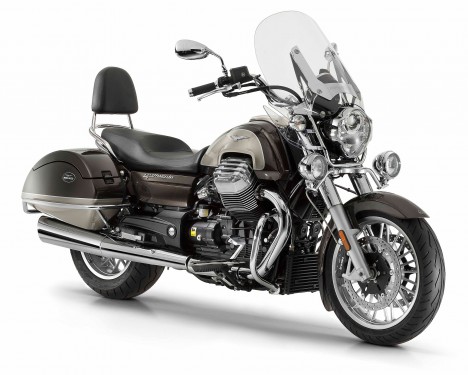
2015 Moto Guzzi California-1400-Touring SE
Thanks to the success of its product ranges, the result of an investment strategy that involved both R&D and restoration of the plant in Mandello del Lario, in 2012 Moto Guzzi – going blatantly against the European market trend – recorded a 15.3% increase in sales. In the first six months of 2013 Moto Guzzi continued this extraordinary curve, documenting an 11.2% increase in the first half of the year compared to the previous one.
In May 2013 Robb Report, the American magazine that has been the International authority and reference point in the luxury segment for almost forty years, listed the big Custom made in Italy at Mandello del Lario among its Best of the Best Luxury Portfolio for 2013.
After receiving unanimous approval all over the world, Moto Guzzi California 1400 adds further important recognition from the United States, taking first place – in August 2013 – in the Cycle World competition’s Cruiser category.

2015 Moto Guzzi V7II Cafe Racer
This recognition takes on that much more significance because it comes from the most authoritative magazine from the other side of the ocean, a true reference point for enthusiasts all over the world, and because precisely the American market is the cradle of large Cruiser bikes, the true flagships of the road, which is teeming with the strong presence of American brands.
